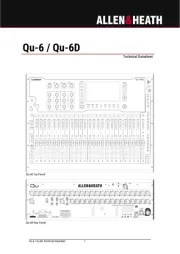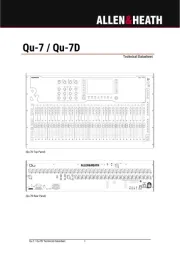Monacor MMX-11 USB Handleiding
Monacor
Mengpaneel
MMX-11 USB
Bekijk gratis de handleiding van Monacor MMX-11 USB (7 pagina’s), behorend tot de categorie Mengpaneel. Deze gids werd als nuttig beoordeeld door 57 mensen en kreeg gemiddeld 4.6 sterren uit 29 reviews. Heb je een vraag over Monacor MMX-11 USB of wil je andere gebruikers van dit product iets vragen? Stel een vraag
Pagina 1/7

wwwwww..iimmggssttaaggeelliinnee..ccoomm
MMX-11USB
Bestellnummer 20.2840
2-Kanal-Audio-Mischer
Bitte lesen Sie diese Anleitung vor dem
Betrieb gründlich durch und heben Sie
sie für ein späteres Nachlesen auf.
1 Einsatzmöglichkeiten
Dieser Miniatur-Mischer mit USB-Schnitt stelle
lässt sich universell verwenden, z. B. für die Ton-
aufnahme am Computer. Er verfügt über 2 Ein-
gangskanäle: 1 × mono mit Mic /Line-Eingang,
1 × stereo mit Line-Eingang. Das Mischsignal
wird über eine 3,5-mm-Klin ken buch se und die
USB-Buchse ausgegeben. Diese lässt sich
auch als Eingang zur Übertragung von Audio -
daten vom Computer zum Mischer nutzen.
Die Stromversorgung erfolgt über das beilie-
gende Netzgerät oder bei Anschluss an einen
Computer über die USB-Verbindung.
2 Sicherheitshinweise
Die Geräte (Mischer und Netzgerät) entspre-
chen allen relevanten Richtlinien der EU und
sind deshalb mit gekennzeichnet.
GSetzen Sie die Geräte nur im Innen bereich
ein. Schützen Sie sie vor Tropf- und Spritz-
wasser, hoher Luftfeuchtigkeit und Hitze (zu-
lässiger Einsatztemperaturbereich 0 – 40 °C).
GNehmen Sie den Mischer nicht in Betrieb und
ziehen Sie sofort das Netzgerät aus der
Steckdose, wenn:
1. sichtbare Schäden an einem der Geräte
vorhanden sind,
2. nach einem Sturz oder Ähnlichem der Ver-
dacht auf einen Defekt besteht,
3. Funktionsstörungen auftreten.
Lassen Sie die Geräte in jedem Fall in einer
Fachwerkstatt reparieren.
GVerwenden Sie zum Reinigen nur ein trocke-
nes, weiches Tuch, niemals Chemikalien oder
Wasser.
GWerden die Geräte zweckentfremdet, nicht
richtig angeschlossen/be dient oder nicht fach -
gerecht repariert, kann keine Haftung für da-
raus resultierende Sach- oder Personenschä-
den und keine Garantie für die Geräte über-
nommen werden.
3 Inbetriebnahme
Vor dem Herstellen/Trennen von Verbindungen
und dem Einschalten sollten die Ausgangsregler
(21, 23) immer ganz zurückgedreht werden.
1) An die kombinierte Buchse MIC/LINE (3) des
Mono-Ka nals ein Mikrofon oder eine Mono-
Ton quelle mit Line-Signalpegel anschließen:
– Ein Mikrofon über einen symmetrisch be-
schalteten XLR-Stecker an schließen. Am
XLR- Anschluss liegt eine 20-V-Phan tom -
span nung an (zum Betrieb eines Konden-
satormikrofons, das mit dieser Phantom-
speisung arbeitet). Vorsicht: Kein Mi kro-
fon mit asymmetrischem Ausgang an-
schließen, da es durch die Phantomspan-
nung be schädigt werden kann!
– Ein Gerät mit Line-Pegel (z. B. Empfänger
eines drahtlosen Mikrofonsystems) über
einen 6,3-mm-Klinkenstecker an schlie ßen.
Der Klin kenanschluss ist symmetrisch be-
schaltet. Es lassen sich aber auch Geräte
mit asymmetrisch beschaltetem Ausgang
über 2-polige Klinkenstecker anschließen.
2) An die Cinch-Buchsen LINE 2/3 (4) des Ste-
reo-Kanals (weiß = linker Kanal, rot = rechter
Kanal) eine Stereo-Tonquelle mit Line-Sig-
nalpegel, z. B. CD-Spieler, anschließen.
3) Einen Stereo-Recorder an die Cinch-Buch-
sen TAPE anschließen: Seinen Ausgang an
den Eingang TAPE IN (5) und seinen Ein-
gang an den Ausgang TAPE OUT (6).
Die Anschlüsse können jedoch auch für
andere Geräte mit Line-Pegel genutzt wer-
den, z. B. lässt sich ein Wiedergabegerät wie
CD- oder MP3-Spieler an TAPE IN anschlie-
ßen oder ein Verstärker an TAPE OUT.
4) Für Abhörzwecke einen Stereo-Kopfhörer
(Im pedanz ≥ 8 Ω) oder den Verstärker einer
kleinen Monitor anlage an die 3,5-mm-Ste reo-
Klin ken buchse BOOTH (8) an schließen.
5) Am Stereo-Ausgang MASTER OUT (7) steht
das mit dem MASTER-Regler (23) einge-
stellte Ausgangssignal zur Verfügung. Hier
kann über einen 3,5-mm-Klinkenstecker z. B.
ein Verstärker oder ein zweites Mischpult an-
geschlossen werden.
6) Bei Betrieb ohne Computer das beiliegende
Netzgerät über ein USB-Kabel mit der USB-
Buchse (1) verbinden und in eine Steckdose
(230 V~ / 50 Hz) stecken (Betrieb mit Compu-
ter Kapitel 3.1).
Wird der Mischer längere Zeit nicht betrie-
ben, das Netzgerät aus der Steckdose zie-
hen, da es selbst bei ausgeschaltetem Mi-
scher einen geringen Strom verbraucht.
7) Zum Einschalten die Taste PWR (2) drücken,
die Betriebsanzeige ON (9) leuchtet. Zum
Ausschalten die Taste wieder ausrasten.
3.1 Betrieb mit Computer
Für den Betrieb des Mischers mit einem Com-
puter kann die mit dem Betriebssystem mitge-
lieferte Audio-Software verwendet werden oder
eine zusätzlich installierte Audio-Software.
1) Den Computer hochfahren und die USB-
Buchse (1) über ein USB-Kabel mit einem
USB-An schluss am Computer verbinden. Der
eingeschaltete Mischer wird vom Computer
als USB-Audiogerät für die Ton eingabe und
Tonausgabe er kannt.
Hinweis: Wird der Mischer nicht als USB-Audio-
gerät erkannt, müssen die erforderlichen Treiber
(Standard-Treiber des Betriebssystems) nach -
installiert werden, z. B. über die Betriebssystem-
Original-CD. Gegebenenfalls nach der Installation
den Computer neu starten.
2) Das Abspiel-/Aufnahmeprogramm aufrufen
und dort die erforderlichen Einstellungen
für die Tonwiedergabe über den Mischer
bzw. Tonaufnahme vom Mischer vornehmen
(An leitung des Programms). Der Mischer
kann dann anhand Kapitel 4 bedient werden.
Findet keine Tonaufnahme bzw. Tonwiedergabe
statt, in den Systemeinstellungen des Compu-
ter-Betriebssystems überprüfen, ob die USB-
Schnittstelle für die Toneingabe bzw. Ton aus-
gabe angewählt ist.
Tipp: Ist der Mischer mit einem Computer verbunden
sowie mit Ge räten, die über ihr Netzkabel ge erdet
sind (z. B. Verstärker), können aufgrund von Masse -
schleifen Brummstörungen auftreten. Um diese zu
beseitigen, kann der Mischer über ein Massetrenn -
filter (z. B. FGA-30 von MONACOR) mit dem jeweili-
gen Gerät verbunden werden.
4 Bedienung
1) Mit der Taste LINE/USB (13) wählen, welches
Eingangssignal dem Kanal 2/3 zugeordnet
wird: Taste nicht gedrückt = Eingangssignal
der Buchsen LINE 2/3 (4), Taste gedrückt =
Eingangssignal der USB-Buchse (1).
Hinweis: Beachten Sie bei Aufnahmen über die
USB-Buchse die Gefahr von Rückkopplungen,
wenn das Aufnahmesignal des Computers dem
Kanal 2/3 als Eingangssignal zugeordnet wird.
2) Zur Grundeinstellung vorerst die Regler
– LEVEL (19, 20) ganz zurückdrehen
– HI, LO (14, 16), PAN (15) und BAL (17) in
die Mittelstellung schieben
– GAIN (12) und MASTER (23) bis zur Mitte
aufdrehen
Ein Tonsignal auf Kanal 1 geben. Den Regler
LEVEL (19) so weit aufdrehen, dass es gut
zu hören ist und der Klang mit den Reglern
HI und LO (14) eingestellt werden kann.
Muss der Regler LEVEL dazu sehr weit auf-
gedreht werden, die Eingangsverstärkung
durch Aufdrehen des Reglers GAIN (12)
er höhen. Leuchtet jedoch die LED PK (18)
länger auf, den Regler GAIN entsprechend
zurückstellen. Die LED PK darf nur bei Sig-
nalspitzen kurz aufflackern.
Den Regler LEVEL von Kanal 1 wieder
ganz zurückdrehen, ein Tonsignal auf Kanal
2/3 ge ben und seinen Regler LEVEL (20) so
weit aufdrehen, dass der Klang mit den Reg-
lern HI und LO (16) eingestellt werden kann.
3) Nach der Grundeinstellung können die Sig-
nale von Kanal 1 und 2/3 mit den Reglern
LEVEL im gewünschten Lautstärkeverhältnis
gemischt oder einzeln ein- und ausgeblendet
werden. Wird ein Kanal nicht be nutzt, seinen
Regler LEVEL ganz zurückdrehen.
4) Für Kanal 1 mit dem Regler PAN (15) das
Mono-Signal im Stereo-Klangbild platzieren
und für Kanal 2/3 mit dem Regler BAL (17)
die Balance des Stereo-Signals einstellen.
5) Um das Signal des Eingangs TAPE IN (5),
der Mischung zuzufügen, die Tas te TAPE TO
MASTER (10) drücken.
Hinweis: Wird eine über den Ausgang TAPE OUT
(6) laufende Aufnahme zeitgleich über den Ein-
gang TAPE IN wiedergegeben, darf die Taste
TAPE TO MASTER nicht ge drückt sein, da sonst
eine Rückkopplung auftritt.
6) Mit dem Regler MASTER (23) den Pegel für
das Ausgangssignal einstellen, das über die
Buchsen MASTER OUT (7), TAPE OUT (6)
und die USB-Buchse (1) ausgegeben wird.
Leuchtet eine der Übersteuerungs-LEDs
CLIP (22), den Regler MASTER oder zu weit
aufgedrehte Kanalregler (19, 20) entspre-
chend zurückdrehen. Damit die LEDs CLIP
auf das Ausgangssignal ansprechen, darf die
Taste TAPE TO BOOTH/PHONES (11) nicht
gedrückt sein (Punkt 7 unten).
7) Mit der Taste TAPE TO BOOTH/PHONES
(11) wählen, welches Signal dem Abhöraus-
gang BOOTH (8) zugeordnet wird: Taste nicht
gedrückt = Ausgangssignal, Taste gedrückt =
Signal des Eingangs TAPE IN (5). Die Über-
steuerungs-LEDs CLIP (22) sprechen auf das
Sig nal an, das für die Ab hörfunktion aus ge -
wählt ist. Die Abhörlautstärke mit dem Regler
BOOTH/PHONES (21) einstellen.
5 Technische Daten
Empfindlichkeit / Impedanz
Mic: . . . . . . . . . . 0,5 mV/1,6 k
Ω
(Gain min. 80 mV)
Line, Kanal 1: . . . 2 mV/10 k
Ω
(Gain min. 550 mV)
Line, Kanal 2/ 3: . 150 mV/10 k
Ω
Tape . . . . . . . . . . 420 mV/7 k
Ω
Ausgangspegel: . . . max. 6 V (Master, Booth, Tape)
Kopfhörerimpedanz: ≥ 8
Ω
USB-Schnittstelle: . USB 2.0 (Full Speed), Buchse Typ B
Frequenzbereich: . . 20 – 20 000 Hz
Klirrfaktor: . . . . . . . < 0,05 %
Störabstand: . . . . . 81 dB (A-bewertet)
Phantomspeisung: . +20 V (XLR), permanent
Stromversorgung: . über USB-Port (5 V/ 500 mA) des
Computers oder über beiliegendes
Netzgerät an 230 V~/ 50 Hz
Maße, Gewicht: . . . 102 × 45 × 140 mm, 430 g
Geeignete Betriebssysteme für den Datentransfer über die
USB-Schnittstelle:
Windows 2000
,
Windows XP
oder nachfolgende
Windows
-
Versionen,
Mac OS 9.0.4
oder höher,
Mac OS X
Windows ist ein registriertes Warenzeichen der Microsoft Cor-
poration in den USA und anderen Ländern.
Mac OS ist ein registriertes Warenzeichen von Apple Computer,
Inc. in den USA und anderen Ländern.
Änderungen vorbehalten.
Sollen die Geräte endgültig aus dem Be-
trieb genommen werden, übergeben Sie sie
zur umweltgerechten Entsorgung einem
örtlichen Recyclingbetrieb.
WARNUNG: Stellen Sie die Laut-
stär ke der Au dio anlage und des
Kopfhörers nie sehr hoch ein. Hohe
Lautstärken können auf Dauer das Ge hör
schä digen! Das Ohr gewöhnt sich an hohe
Lautstärken und empfindet sie nach einiger
Zeit als nicht mehr so hoch. Darum er höhen
Sie eine hohe Lautstärke nach der Ge wöh-
nung nicht weiter.
WARNUNG: Das Netzgerät wird
mit lebensgefähr licher Netzspan-
nung versorgt. Nehmen Sie des-
halb niemals selbst Eingriffe daran vor. Durch
unsachgemäßes Vorgehen besteht die Gefahr
eines elektrischen Schlages.
MONACOR INTERNATIONAL GmbH & Co. KG • Zum Falsch 36 • 28307 Bremen • Germany. Copyright
©by MONACOR INTERNATIONAL. All rights reserved. A-1474.99.01.11.2013
®
D
A
CH

wwwwww..iimmggssttaaggeelliinnee..ccoomm
MMX-11USB
Order No. 20.2840
2-Channel Audio Mixer
Please read these operating instructions care-
fully prior to operation and keep them for later
reference.
1 Applications
This miniature mixer with USB interface is de-
signed for universal applications, e. g. for audio
recordings on the computer. It is equipped with
2 input channels: 1 × mono with mic / line input;
1 × stereo with line input. The mixed signal is
sent to a 3.5 mm jack and the USB port. The
USB port is also suited as an input to transfer
audio data from the computer to the mixer.
The mixer is supplied with power via the
power supply unit provided or, when connected
to a computer, via the USB connection.
2 Safety Notes
The units (mixer and power supply unit) corre-
spond to all relevant directives of the EU and are
therefore marked with .
GThe units are suitable for indoor use only. Pro-
tect them against dripping water and splash
water, high air humidity and heat (admissible
ambient temperature range: 0 – 40 °C).
GDo not operate the mixer and immediately dis-
connect the power supply unit from the socket
1. if one of the units is visibly damaged,
2. if a defect might have occurred after a unit
was dropped or suffered a similar accident,
3. if malfunctions occur.
In any case the units must be repaired by
skilled personnel.
GFor cleaning only use a dry, soft cloth; never
use water or chemicals.
GNo guarantee claims for the units and no lia-
bility for any resulting personal damage or
material damage will be accepted if the units
are used for other purposes than originally in-
tended, if they are not correctly connected or
operated, or if they are not repaired in an ex-
pert way.
3 Setting the Mixer into Operation
Prior to connecting / disconnecting and prior to
switching on, always turn back the output con-
trols (21, 23) to the left stop.
1) Connect a microphone or a mono audio
source with line signal level to the combined
jack MIC / LINE (3) of the mono channel:
– Connect a microphone via a balanced XLR
plug. A 20 V phantom power is available at
the XLR jack (for operating a condenser
microphone using this phantom power).
Caution: Do not connect any microphone
with unbalanced output; it may be dam-
aged by the phantom power!
– Connect a unit with line level (e. g. receiver
of a wireless microphone system) via a
6.3 mm plug. The 6.3 mm jack is balanced.
To connect units with unbalanced output,
use 2-pole 6.3 mm plugs.
2) Connect a stereo audio source with line sig-
nal level (e. g. CD player) to the RCA jacks
LINE 2 / 3 (4) of the stereo channel (white =
left channel; red = right channel).
3) Connect a stereo recorder to the RCA jacks
TAPE: Connect its output to the input TAPE IN
(5) and its input to the output TAPE OUT (6).
These jacks may also be used for other
units with line level, e. g. to connect a player
(CD player or MP3 player) to TAPE IN or an
amplifier to TAPE OUT.
4) For monitoring purposes, connect stereo
headphones (impedance ≥ 8 Ω) or the ampli-
fier of a small monitor system to the 3.5 mm
stereo jack BOOTH (8).
5) The stereo output MASTER OUT (7) provides
the output signal adjusted with the MASTER
control (23). To connect, for example, an am-
plifier or a second mixer to this output, use a
3.5 mm plug.
6) When operating the mixer without a com-
puter, use a USB cable to connect the power
supply unit provided to the USB port (1), then
connect the power supply unit to a mains
socket (230 V~ / 50 Hz) [operation with a com-
puter chapter 3.1].
Always disconnect the power supply unit
from the socket when the mixer is not in use
for a longer period of time; even when the
mixer has been switched off, the power sup-
ply unit will have a low power consumption.
7) To switch on, press the button PWR (2); the
power LED ON (9) lights up. To switch off,
disengage the button.
3.1 Operation with a computer
When operating the mixer with a computer,
either use the audio software supplied with the
operating system or audio software installed
additionally.
1) Start the computer. Use a USB cable to con-
nect the USB port (1) to a USB connection on
the computer. The computer will recognize
the switched-on mixer as a USB audio device
for audio input and audio output.
Note: If the computer fails to recognize the mixer
as an USB audio device, install the drivers required
(default drivers of the operating system), e. g. by
means of the original CD of the operating system.
If necessary, restart the computer after installing
the drivers.
2) Call up the replay/recording program and
make the settings required for audio repro-
duction via the mixer or audio recording from
the mixer (manual of the program). The
mixer can then be operated as described in
chapter 4.
If no audio recording or audio reproduction is
possible, check the system settings of the com-
puter to find out if the USB interface has been
selected for audio input or audio output.
Hint: If the mixer is connected to both a computer and
to units earthed via their mains cable (e. g. amplifiers),
hum interference may occur due to ground loops.
To eliminate this interference, use a ground isolator
(e. g. FGA-30 from MONACOR) to connect the mixer
to the corresponding unit.
4 Operation
1) Use the button LINE / USB (13) to select the
input signal assigned to channel 2/3: button
disengaged = input signal of the jacks LINE
2/3 (4); button engaged = input signal of the
USB jack (1).
Note: For recordings via the USB port, please take
into account that there is a risk of feedback if the
recording signal of the computer is assigned to
channel 2 / 3 as an input signal.
2) For the basic setting, first set the controls
– LEVEL (19, 20) to the left stop
– HI, LO (14, 16), PAN (15) and BAL (17) to
mid-position
– GAIN (12) and MASTER (23) to mid-posi-
tion
Feed an audio signal to channel 1. Turn up
the control LEVEL (19) until the audio signal
can be heard well and it is possible to adjust
its sound with the controls HI and LO (14). If
you have to turn up the control LEVEL very
far, turn up the control GAIN (12) to increase
the input gain. However, if the LED PK (18)
lights up for a longer period of time, turn back
the control GAIN accordingly. The LED PK
should briefly flash for signal peaks only.
Turn back the control LEVEL of channel 1.
Feed an audio signal to channel 2 / 3 and turn
up its control LEVEL (20) until it is possible to
adjust the sound with the controls HI and LO
(16).
3) After the basic setting, use the controls
LEVEL to mix the signals of channels 1 and
2/3 in the volume ratio desired or to fade
them in or out individually. When a channel is
not used, always turn back its control LEVEL
to the left stop.
4) For channel 1, use the control PAN (15) to
place the mono signal in the stereo sound.
For channel 2 / 3, use the control BAL (17) to
adjust the balance of the stereo signal.
5) To add the signal of the input TAPE IN (5) to
the audio mix, press the button TAPE TO
MASTER (10).
Note: When a recording is made via the output
TAPE OUT (6) and at the same time reproduced
via the input TAPE IN, make sure that the button
TAPE TO MASTER is disengaged; otherwise,
there will be feedback.
6) Use the control MASTER (23) to adjust the
level of the output signal sent to the jacks
MASTER OUT (7), TAPE OUT (6) and the
USB port (1). If one of the overload LEDs
CLIP (22) lights up, turn back the control
MASTER or any channel control (19, 20)
turned up too far. Make sure that the button
TAPE TO BOOTH / PHONES (11) is disen-
gaged so that the LEDs CLIP will be able to
respond to the output signal [item 7
below].
7) Use the button TAPE TO BOOTH / PHONES
(11) to select the signal assigned to the mon-
itor output BOOTH (8): button disengaged =
output signal; button engaged = signal of the
input TAPE IN (5). The overload LEDs CLIP
(22) respond to the signal selected for the
monitor function. Use the control BOOTH /
PHONES (21) to adjust the monitoring vol-
ume.
5 Specifications
Sensitivity / impedance
Mic: . . . . . . . . . . 0.5 mV/1.6 k
Ω
(gain min.: 80 mV)
Line, channel 1: . 2 mV/10 k
Ω
(gain min.: 550 mV)
Line, channel 2/ 3: 150 mV/10 k
Ω
Tape: . . . . . . . . . 420 mV/7 k
Ω
Output level: . . . . . 6 V max. (Master, Booth, Tape)
Headphone
impedance: . . . . . . ≥ 8
Ω
USB interface: . . . . USB 2.0 (Full Speed), type B port
Frequency range: . 20 – 20 000 Hz
THD: . . . . . . . . . . . < 0.05 %
S / N ratio: . . . . . . . . 81 dB (A weighted)
Phantom power: . . +20 V (XLR), permanent
Power supply: . . . . via USB port (5 V/ 500 mA) of the
computer or via power supply unit
provided and connected to 230 V~ /
50 Hz
Dimensions, weight: 102 × 45 × 140 mm, 430 g
Suitable operating systems for data transfer via USB
interface:
Windows 2000, Windows XP
or subsequent
Windows
versions,
Mac OS 9.0.4
or later,
Mac OS X
Windows is a registered trademark of Microsoft Corporation in
the USA and other countries.
Mac OS is a registered trademark of Apple Computer, Inc. in
the USA and other countries.
Subject to technical modification.
WARNING: Never adjust the audio
system and the headphones to a
very high volume. Permanent high
volumes may damage your hearing! Your ear
will get accustomed to high volumes which do
not seem to be that high any more after some
time. Therefore, do not further increase a high
volume after getting used to it.
If the units are to be put out of operation
definitively, take them to a local recycling
plant for a disposal which is not harmful to
the environment.
WARNING: The power supply unit
uses dangerous mains voltage.
Leave servicing to skilled person-
nel. Inexpert handling or modification may re-
sult in electric shock.
MONACOR INTERNATIONAL GmbH & Co. KG • Zum Falsch 36 • 28307 Bremen • Germany. Copyright
©by MONACOR INTERNATIONAL. All rights reserved. A-1474.99.01.11.2013
®
GB

wwwwww..iimmggssttaaggeelliinnee..ccoomm
MMX-11USB
Réf. num. 20.2840
Table de mixage audio
2 canaux
Veuillez lire la présente notice avec
attention avant le fonctionnement et
conservez-la pour pouvoir vous y repor-
ter ultérieurement.
1 Possibilités dʼutilisation
Cette table de mixage miniature avec interface
USB est conçue pour une utilisation universelle,
par exemple pour un enregistrement audio sur
un ordinateur. Elle dispose de deux canaux
dʼentrée : 1 × mono avec entrée Mic / Ligne, 1 ×
stéréo avec entrée Ligne. Le signal de mixage
est disponible à la prise jack 3,5 et au port USB.
Ce dernier peut également être utilisé comme
entrée pour transmettre des données audio de
lʼordinateur vers la table de mixage.
Lʼalimentation sʼeffectue via le bloc secteur
livré ou via le port USB si vous reliez la table de
mixage à un ordinateur.
2 Conseils dʼutilisation et de sécurité
Les appareils (table de mixage et bloc secteur) ré-
pondent à toutes les directives nécessaires de
lʼUnion européenne et portent donc le symbole .
GLes appareils ne sont conçus que pour une
utilisation en intérieur. Protégez-les des écla-
boussures, de tout type de projections dʼeau,
dʼune humidité dʼair élevée et de la chaleur
(température ambiante admissible 0 – 40 °C).
GNe faites pas fonctionner la table de mixage et
débranchez le bloc secteur immédiatement
dans les cas suivants :
1. un des appareils présente des dommages
visibles.
2. après une chute ou accident similaire, vous
avez un doute sur lʼétat de lʼappareil.
3. des dysfonctionnements apparaissent.
Dans tous les cas, les dommages doivent être
réparés par un technicien spécialisé.
GPour le nettoyage, utilisez un chiffon sec et
doux, en aucun cas de produits chimiques ou
dʼeau.
GNous déclinons toute responsabilité en cas de
dommages corporels ou matériels résultants
si les appareils sont utilisés dans un but autre
que celui pour lequel ils ont été conçus, sʼils
ne sont pas correctement branchés ou utili-
sés ou sʼils ne sont pas réparés par une per-
sonne habilitée ; en outre, la garantie devien-
drait caduque.
3 Fonctionnement
Avant dʼeffectuer les branchements ou de les
séparer et avant dʼallumer la table de mixage, il
faut mettre les réglages de sortie (21, 23) tou-
jours entièrement vers la gauche.
1) Reliez un micro ou une source audio mono
avec niveau de signal ligne à la prise combo
MIC / LINE (3) du canal mono :
– Reliez un micro via une fiche XLR symé-
trique. Une alimentation fantôme 20 V est
présente à la prise XLR (pour faire fonc-
tionner un microphone à condensateur
fonctionnant avec cette alimentation fan-
tôme). Attention : Ne reliez pas de micro-
phone avec sortie asymétrique, il peut être
endommagé par lʼalimentation fantôme !
– Reliez un appareil avec niveau ligne (par
exemple récepteur dʼun système de micro
sans fil) via une fiche jack 6,35. La prise
jack est symétrique. Il est également pos-
sible de relier des appareils avec sortie
asymétrique via une fiche jack 2 pôles.
2) Reliez une source audio stéréo avec niveau
de signal ligne, par exemple lecteur CD, aux
prises RCA LINE 2 / 3 (4) du canal stéréo
(blanc = canal gauche, rouge = canal droit).
3) Reliez un enregistreur stéréo aux prises RCA
TAPE : reliez sa sortie à lʼentrée TAPE IN (5)
et son entrée à la sortie TAPE OUT (6).
Les branchements peuvent également
être utilisés pour dʼautres appareils avec ni-
veau ligne, par exemple on peut relier un lec-
teur tel que lecteur CD ou MP3 à TAPE IN ou
un amplificateur à TAPE OUT.
4) Reliez un casque stéréo (impédance ≥ 8 Ω)
ou lʼamplificateur dʼune petite installation mo-
niteur à la prise jack 3,5 stéréo BOOTH (8)
pour une écoute du signal.
5) Le signal de sortie réglé avec le réglage
MASTER (23) est disponible à la sortie stéréo
MASTER OUT (7). On peut ici, par exemple,
relier un amplificateur ou une seconde table
de mixage via une fiche jack 3,5.
6) Pour un fonctionnement sans ordinateur, re-
liez le bloc secteur livré via un cordon USB au
port USB (1) et à une prise secteur 230 V~/
50 Hz (fonctionnement avec un ordinateur,
chapitre 3.1).
En cas de non utilisation prolongée de la
table de mixage, débranchez le bloc secteur,
car même si la table de mixage est éteinte, il
a une faible consommation.
7) Pour allumer, enfoncez la touche PWR (2), le
témoin de fonctionnement ON (9) brille. Pour
éteindre, désenclenchez la touche.
3.1 Fonctionnement avec un ordinateur
Pour faire fonctionner la table de mixage avec
un ordinateur, vous pouvez utiliser le logiciel
audio livré avec le système dʼexploitation ou un
logiciel audio installé en plus.
1)
Démarrez lʼordinateur et reliez le port USB (1)
via un cordon USB au branchement USB de
lʻordinateur. La table de mixage allumée est re-
connue par lʼordinateur comme appareil audio
USB pour lʼentrée audio et la sortie audio.
Remarque: Si la table de mixage nʼest pas recon-
nue comme appareil audio USB, il faut installer les
drivers nécessaires (drivers standard du système
dʼexploitation), p. ex. via le CD dʼorigine du sys-
tème dʼexploitation. Le cas échéant, redémarrez
lʼordinateur après lʼinstallation.
2) Appelez le programme de lecture / dʼenregis-
trement et effectuez les réglages nécessaires
pour la lecture audio via la table de mixage
ou lʼenregistrement audio depuis la table de
mixage (notice du programme). La table
de mixage peut ensuite être utilisée comme
décrit au chapitre 4.
Sʼil nʼy a pas dʼenregistrement audio ou de lec-
ture audio, vérifiez dans les réglages système
du système dʼexploitation de lʼordinateur si lʼin-
terface USB est sélectionnée pour lʼentrée audio
ou la sortie audio.
Conseil : Si la table de mixage est reliée à un ordi-
nateur et à des appareils mis à la terre via leur cordon
secteur (p. ex. amplificateurs), des ronflements cau-
sés par des bouclages de masse peuvent se pro-
duire. Pour les éliminer, on peut relier la table de
mixage à lʼappareil correspondant via un filtre sépa-
rateur galvanique (p. ex. FGA-30 de MONACOR).
4 Utilisation
1) Avec la touche LINE/USB (13) sélectionnez
quel signal dʼentrée est attribué au canal 2 /3 :
touche non enfoncée = signal dʼentrée des
prises LINE 2 / 3 (4), touche enfoncée = signal
dʼentrée du port USB (1).
Remarque : Faites attention aux risques de larsen
en cas dʼenregistrements via le port USB si le si-
gnal dʼenregistrement de lʼordinateur est attribué
au canal 2 / 3 comme signal dʼentrée.
2) Pour effectuer les réglages de base :
– tournez les réglages LEVEL (19, 20) entiè-
rement à gauche
– mettez les réglages HI, LO (14, 16), PAN
(15) et BAL (17) sur la position médiane
– tournez les réglages GAIN (12) et MAS-
TER (23) jusquʼau milieu
Appliquez un signal audio au canal 1. Tour-
nez le réglage LEVEL (19) jusquʼà ce que le
signal soit bien audible et que la tonalité
puisse être réglée avec les réglages HI et LO
(14). Si le réglage LEVEL doit être tourné
très loin, augmentez lʼamplification dʼentrée
en tournant le réglage GAIN (12) vers la
droite. Si cependant la LED PK (18) brille plus
longtemps, tournez le réglage GAIN vers la
gauche en conséquence pour diminuer. La
LED PK ne doit briller que brièvement pour
des pointes de signal.
Tournez le réglage LEVEL du canal 1 en-
tièrement vers la gauche, appliquez un signal
audio sur le canal 2 / 3 et tournez son réglage
LEVEL (20) jusquʼà ce que la tonalité puisse
être réglée avec les réglages HI et LO (16).
3) Une fois les réglages de base effectués, vous
pouvez mixer les signaux des canaux 1 et 2/3
avec les réglages LEVEL dans le rapport de
volume souhaité ou les faire entrer et sortir
séparément. Si un canal nʼest pas utilisé,
tournez son réglage LEVEL entièrement vers
la gauche.
4) Pour le canal 1, placez le signal mono dans
lʼimage sonore stéréo avec le réglage PAN
(15) et pour le canal 2 / 3, réglez la balance du
signal stéréo avec le réglage BAL (17).
5) Pour ajouter le signal de lʼentrée TAPE IN (5)
au mixage, appuyez sur la touche TAPE TO
MASTER (10).
Remarque : Si un enregistrement en cours via la
sortie TAPE OUT (6) est simultanément restitué via
lʼentrée TAPE IN, la touche TAPE TO MASTER ne
doit pas être enfoncée sinon il y a des larsens.
6) Avec le réglage MASTER (23), réglez le ni-
veau pour le signal de sortie disponible aux
prises MASTER OUT (7), TAPE OUT (6) et au
port USB (1). Si une des LEDs de surcharge
CLIP (22) brille, tournez le réglage MASTER
ou des réglages de canal (19, 20) positionnés
trop loin, vers la gauche. Pour que les LEDs
CLIP répondent au signal de sortie, la touche
TAPE TO BOOTH / PHONES (11) ne doit pas
être enfoncée (point 7 ci-dessous).
7) Avec la touche TAPE TO BOOTH / PHONES
(11), sélectionnez quel signal doit être attri-
bué à la sortie dʼécoute BOOTH (8) : touche
non enfoncée = signal de sortie, touche en-
foncée = signal de lʼentrée TAPE IN (5). Les
LEDs de surcharge CLIP (22) répondent au
signal sélectionné pour la fonction dʼécoute.
Réglez le volume dʼécoute avec le réglage
BOOTH / PHONES (21).
5 Caractéristiques techniques
Sensibilité d’entrée / impédance
Mic . . . . . . . . . . . . . 0,5 mV/1,6 k
Ω
(gain min. 80 mV)
Line, canal 1 . . . . . 2 mV/10 k
Ω
(gain min. 550 mV)
Line, canal 2 / 3 . . . 150 mV/ 10 k
Ω
Tape . . . . . . . . . . . 420 mV/ 7 k
Ω
Niveau de sortie . . . . 6 V max. (Master, Booth, Tape)
Impédance casque . . ≥ 8
Ω
Interface USB . . . . . . USB 2.0 (Full Speed), prise type B
Bande passante . . . . 20 – 20 000 Hz
Taux de distorsion . . . < 0,05 %
Rapport signal / bruit : . 81 dB (A pondéré)
Alimentation fantôme : +20 V (XLR), permanent
Alimentation : . . . . . . via port USB (5 V/ 500 mA) de
l’ordinateur ou via bloc secteur livré
relié à 230 V~ / 50 Hz
Dimensions, poids : . . 102 × 45 × 140 mm, 430 g
Systèmes d’exploitation adaptés pour le transfert de
données via le port USB :
Windows 2000, Windows XP
ou versions
Windows
suivantes,
Mac OS 9.0.4
ou supérieur,
Mac OS X
Windows est une marque déposée de Microsoft Corporation aux
Etats-Unis et dans les autres pays.
Mac OS est une marque déposée de Apple Computer, Inc. aux
Etats-Unis et dans les autres pays.
Tout droit de modification réservé.
AVERTISSEMENT : Ne réglez pas le
volume de lʼinstallation audio et du
casque trop fort. Un volume trop
élevé peut, à long terme, générer des troubles
de lʼaudition. Lʼoreille sʼhabitue à des volumes
élevés et ne les perçoit plus comme tels au bout
dʼun certain temps. Nous vous conseillons donc
de régler le volume et de ne plus le modifier.
Lorsque les appareils sont définitivement re-
tirés du service, vous devez les déposer dans
une usine de recyclage de proximité pour
contribuer à leur élimination non polluante.
AVERTISSEMENT : Le bloc secteur
est alimenté par une tension dan-
gereuse. Ne touchez jamais lʼinté-
rieur de lʼappareil car, en cas de mauvaise ma-
nipulation, vous pouvez subir une décharge
électrique.
MONACOR INTERNATIONAL GmbH & Co. KG • Zum Falsch 36 • 28307 Bremen • Germany. Copyright
©by MONACOR INTERNATIONAL. All rights reserved. A-1474.99.01.11.2013
®
F
B
CH
Product specificaties
| Merk: | Monacor |
| Categorie: | Mengpaneel |
| Model: | MMX-11 USB |
Heb je hulp nodig?
Als je hulp nodig hebt met Monacor MMX-11 USB stel dan hieronder een vraag en andere gebruikers zullen je antwoorden
Handleiding Mengpaneel Monacor

24 Juni 2023

16 Juni 2023

12 Juni 2023

10 Juni 2023

9 Juni 2023

9 Juni 2023

7 Juni 2023

3 Juni 2023

19 Februari 2023

2 Juni 2023
Handleiding Mengpaneel
- Chandler
- Harman Kardon
- RDL
- Camry
- Auna
- Shakmat
- Philco
- Valcom
- Stirling
- DAP Audio
- Vonyx
- Krups
- JBL
- Adastra
- Alesis
Nieuwste handleidingen voor Mengpaneel

8 September 2025

8 September 2025

8 September 2025

8 September 2025

12 Augustus 2025

12 Augustus 2025

11 Augustus 2025

11 Augustus 2025

11 Augustus 2025

11 Augustus 2025